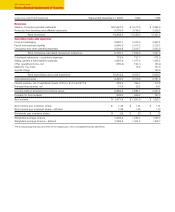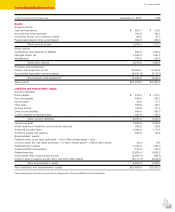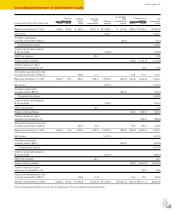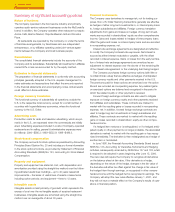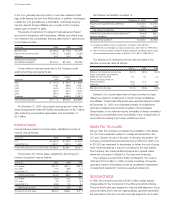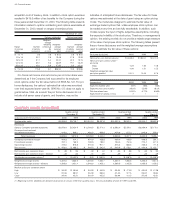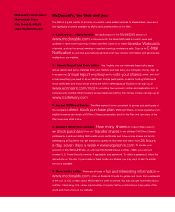McDonalds 2000 Annual Report Download - page 42
Download and view the complete annual report
Please find page 42 of the 2000 McDonalds annual report below. You can navigate through the pages in the report by either clicking on the pages listed below, or by using the keyword search tool below to find specific information within the annual report.
Summary of significant accounting policies
Nature of business
The Company operates in the food service industry and primarily
operates quick-service restaurant businesses under the McDonald’s
brand. In addition, the Company operates other restaurant concepts:
Aroma Café, Boston Market, Chipotle Mexican Grill and Donatos
Pizza.
All restaurants are operated by the Company or, under the terms
of franchise arrangements, by franchisees who are independent
entrepreneurs, or by affiliates operating under joint-venture agree-
ments between the Company and local business people.
Consolidation
The consolidated financial statements include the accounts of the
Company and its subsidiaries. Substantially all investments in affiliates
owned 50% or less are accounted for by the equity method.
Estimates in financial statements
The preparation of financial statements in conformity with accounting
principles generally accepted in the U.S. requires management to
make estimates and assumptions that affect the amounts reported
in the financial statements and accompanying notes. Actual results
could differ from those estimates.
Foreign currency translation
The functional currency of substantially all operations outside the
U.S. is the respective local currency, except for a small number of
countries with hyperinflationary economies, where the functional
currency is the U.S. Dollar.
Advertising costs
Production costs for radio and television advertising, which are pri-
marily in the U.S., are expensed when the commercials are initially
aired. Advertising expenses included in costs of Company-operated
restaurants and in selling, general & administrative expenses were
(in millions): 2000–$595.3; 1999–$522.9; 1998–$486.3.
Stock-based compensation
The Company accounts for stock options as prescribed by Accounting
Principles Board Opinion No. 25 and includes pro forma information
in the stock options footnote, as provided by Statement of Financial
Accounting Standards (SFAS) No. 123, Accounting for Stock-Based
Compensation.
Property and equipment
Property and equipment are stated at cost, with depreciation and
amortization provided using the straight-line method over the follow-
ing estimated useful lives: buildings—up to 40 years; leasehold
improvements—the lesser of useful lives of assets or lease terms
including option periods; and equipment—three to 12 years.
Intangible assets
Intangible assets consist primarily of goodwill, which represents the
excess of cost over the net tangible assets of acquired restaurant
businesses. Intangible assets are amortized using the straight-line
method over an average life of about 30 years.
Financial instruments
The Company uses derivatives to manage risk, not for trading pur-
poses. Non-U.S. Dollar financing transactions generally are effective
as hedges of either long-term investments in, or intercompany loans
to, foreign subsidiaries and affiliates. Foreign currency translation
adjustments from gains and losses on hedges of long-term invest-
ments are recorded in shareholders’ equity as other comprehensive
income. Gains and losses related to hedges of intercompany loans
offset the gains and losses on intercompany loans and are recorded
in nonoperating expense, net.
Interest-rate exchange agreements are designated and effective
to modify the Company’s interest-rate exposures. Net interest is
accrued as either interest receivable or payable, with the offset
recorded in interest expense. Gains or losses from the early termina-
tion of interest-rate exchange agreements are amortized as an
adjustment to interest expense over the shorter of the remaining life
of the interest-rate agreement or the underlying debt being hedged.
The Company purchases foreign currency options (with little or
no initial intrinsic value) that are effective as hedges of anticipated
foreign currency royalty and other payments received in the U.S.
The premiums paid for these options are amortized over the option
life and are recorded as nonoperating expense. Any realized gains
on exercised options are deferred and recognized in the period in
which the related royalty or other payment is received.
Forward foreign exchange contracts are also used to mitigate
exposure on foreign currency royalty and other payments received
from affiliates and subsidiaries. These contracts are marked to
market with the resulting gains or losses recorded in nonoperating
expense, net. In addition, forward foreign exchange contracts are
used to hedge long-term investments in foreign subsidiaries and
affiliates. These contracts are marked to market with the resulting
gains or losses recorded in shareholders’ equity as other compre-
hensive income.
If a hedged item matures or is extinguished, or if a hedged antici-
pated royalty or other payment is no longer probable, the associated
derivative is marked to market with the resulting gain or loss recog-
nized immediately. The derivative is then redesignated as a hedge of
another item or terminated.
In June 1998, the Financial Accounting Standards Board issued
SFAS No.133, Accounting for Derivative Instruments and Hedging
Activities, subsequently amended by SFAS Nos.137 and 138, which
is required to be adopted in years beginning after June 15, 2000.
The new rules will require the Company to recognize all derivatives
on the balance sheet at fair value. If the derivative is a hedge,
depending on the nature of the hedge, changes in the fair value of
the derivative will either be offset against the change in fair value of
the hedged item through earnings, or recognized in other compre-
hensive income until the hedged item is recognized in earnings. The
Company will adopt the new rules effective January 1, 2001, and
they will not have a material effect on the Company’s results of oper-
ations or financial position.
Financial comments
40 Financial review








